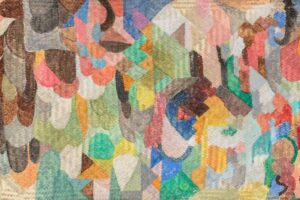Reenchanting the World

Sofía Echeverri has researched the role of women in ancient civilizations and reclaimed their transcendence in a bid to rectify the historic sources. This time she takes her inspiration from The Goddesses and Gods of Old Europe (1974), in which the Lithuanian archaeologist Marija Gimbutas suggests that a matrifocal culture governed by a “Great Goddess” existed among the early farmers of the Balkans and neighboring regions (Rumania, Bulgaria, Hungary, Moldavia, Macedonia, the Adriatic and Aegean oceans, etc.). Could the female of the species have been the creative force that predated the Heavenly Father imposed by Judaism, Christianism and Islam? In terms of iconography, composition and technique, Sofía Echeverri´s current paintings employ: 1) the archetype of the serpent, 2) geometrical patterns in soft tones and 3) woven palm mats as a medium. Simple, sinuous strokes and an absence of perspective ensure the eye remains focused on the essential. Conversely, the ethnographic argument is illustrated in complementary drawings that document the worship of female deities in these regions. The Great Goddess has her epiphany in the serpent, which emerges from the water, gives birth to the cosmic egg and is the receptacle of esoteric knowledge. A first group of paintings shows a black serpent slithering against neutral backgrounds or ones that are fragmented like colored tiles, which, in turn, are superimposed on the woven surface of the mat: three levels of rhythm and formal symmetry that appear to attenuate the aesthetic impact so as to accentuate the spiritual transfiguration of the body and the connection with the divine inferred by the symbols. In a second hall, an installation inspired by the cairn of Gavrinis (France) brims over with tectonic and sexual references. By tattooing the walls with concentric semicircles in chalk, Sofía Echeverri not only recreates the Neolithic sanctuary where, according to the official version, the dead were worshipped, but suggests another interpretation: that the centrifugal design of Gavrinis represents none other than the waves of the female orgasm, a hypothesis that leads her to deduce that this temple was built to honor the pleasure and fertility of women. A certain hypnotic quality takes us from one hall to another. In the rhombuses of the “cave,” with its traces of vulva and snake scales, and the semi-abstract palm mats, the upward drive evokes life energy in its purest form, which emerges, is released and is regenerated in endless cycles. Consistent with the invisible (and invisibilized) powers Gimbutas analyzes in her book, Sofía Echeverri´s works have a conciliatory intention that can best be described as a desire to reenchant the world— sylvia navarrete
